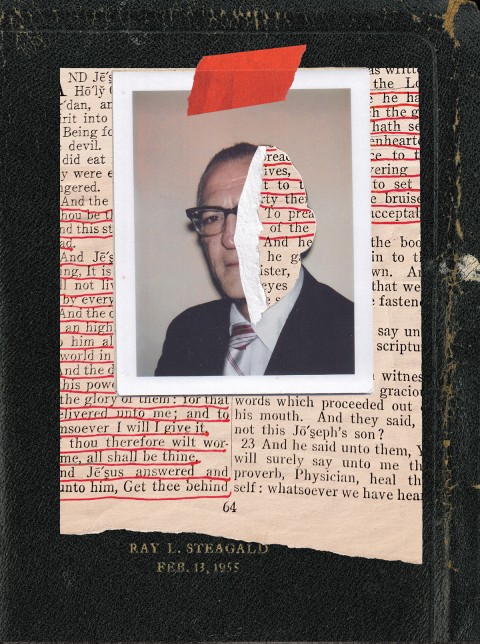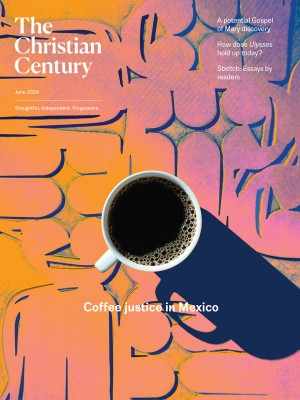My dad’s old Bible offers more questions than answers
What can I learn from what he underlined—or didn’t?

(Illustration by Vanessa Saba)
I inherited my dad’s bible, a battered old Thompson Chain-Reference (KJV), upon his death in 1988. It is an amazing storehouse of information that Frank Charles Thompson assembled in hopes of couching the scriptures in “simple yet scholarly” terms for interested and studious laypeople—as well as for struggling preachers like Dad. The genesis of Thompson’s project, in fact, was his frustration regarding the limitations of reference Bibles in his time. The result, first published in 1908, was a block of righteousness that Dad considered an indefatigable doorstop to keep closed all the gates of hell.
Each double page of sacred text is flanked and guttered with cross references (more than 100,000 in all). In the back are a concordance, thick indexes of explanatory notes, and in-depth character studies. There is a plenitude of charts and maps, not to mention the complex “chains” of Thompson’s references (more than 4,000).
Read our latest issue or browse back issues.
Dad’s particular copy presents as a leathery, tough veteran: unyielding and strong, the kind of book you want on your side in a personal theological throw-down or in a battle in whatever war the culture might be fighting. True to the part, the book has taken some hits: it has scars, and its increasingly brittle stiffness suggest it might be time for a Purple Heart and an honorable discharge.
By the time I got my hands on it, the black cover had already passed through its “old jacket” comfort stage and had begun to harden again. There were cracks in places, and a couple of dry open wounds—proof of its dutiful, unyielding protection of its tender innards, edge-gilded pages thin as onionskin. Stamped onto the front cover—in letters still visibly gold—are his name, Ray L. Steagald, and a date, February 13, 1955. I was born five weeks before, on January 4.
Dad had recently received a call to Bradley’s Creek Baptist Church, a beautiful little white-framed building in the small town of Lascassas, Tennessee. Bradley’s Creek’s quick gathered across the gravel road from Bradley’s Creek’s dead—in a building with two front doors, one for the women and one for the men. Dad preached for two short seasons during two brief tenures at Bradley’s Creek.
In lovely script, someone wrote on one of the stiff blank pages just inside the Bible’s cover:
This Bible was presented
to Ray L. Steagald by
the Radnor Baptist
Church on the day
of his ordination to
the full work of the gospel ministry.
February 13, 1955
Nashville Tennessee
The facing page is blank and loose. Whatever binding glue once held the two together has let go completely. Now, what appears to be a wide incision—you can see down to the spine—separates the pages. I have wondered if Dad might have pulled those pages wide, the better to see the inscription. I do imagine he regularly pondered that day, those words, and his hope for a full life’s work in gospel ministry—a hope that never came to be. He lacked college or seminary training, having gone to work with the WPA during the Depression, so no church that could have supported his young family and his new mortgage ever came calling. Nor was he able to itinerate, as he was landlocked on three-eighths of an acre in south Nashville.
He was like Simon and Andrew, always fishing the shallows—Bradley’s Creek, Eastwood, Calvary—while the Jameses and Johns he knew and resented fished in the deeps. Self-loathing metastasized into bitterness (for lack of faith, he said, more than lack of education, and for lapses in moral rectitude he could neither confess nor forget). At the end he was not only diminished but withered: shriveled in body and soul.
Knowing how it ended, I wish I knew more of how it began.
Even now, I take his Bible from its practical crypt in my study, open to the elegant inscription, and reflect on one phrase: “the full work of the gospel ministry.” What might that be, after all? When the covers are pulled open? Beneath the dry layers of routine labors? Preaching, yes, but what else? Teaching, likewise. Visiting the sick. Administering the sacraments (though Dad could only go the ordinance route) or the life of the church. To what end?
Dad did not live long enough—nor, while I was in college or seminary, was either of us brave enough—to ask or answer those questions for him. All these years later, I would like to know how he thought about what he thought he was doing. I have a few of his sermons still, which are propositional, moralistic, illustration-less. I know he was doing the best he could, thinly echoing Calvin and imitating Calvin’s followers who inspired him. I would just like to know how and why that kind of preaching and theology spoke to and motivated him to ministry.
I think it would have something to do with fear.
In any case, I take the time, now and then, to carefully thumb through his Bible itself, trying to get to know him better by noting and reading the verses and sections that must have spoken to him especially, given the highlighting and underlining. And also by noting those verses, chapters, and books that are not only unmarked but feel unread, were perhaps unconsidered and certainly unrealized in the full work of his ministry and personal discipleship.
For the latter, I often have to peel the onion: pull apart the pages that stick together, that ward large swaths of Bible where there is no underlining at all and no sense that he read them or began to do what they said.
In a place or two, the prophets’ call to welcome the stranger and defend the widow and orphan are underlined in red, as is Jesus’ reiteration of Jubilee in Luke 4 as the full measure of social ethics: “good news to the poor, release to the captives, liberty for those who are oppressed.” But if I know Dad at all, he came at those texts in a self-identifying, evangelical, and spiritualized way: that he was poor, wretchedly captive to his moral failings, and oppressed by guilt but—praise the Lord!—now has been set free by faith in Jesus. Something like that.
Whether or not Dad (or others like him) actually felt free or joyful (he didn’t) seems beside the point. In other words, he believed the gospel but only in a personal, pietistic, salvific kind of way. Most of his ethics were individual and prohibitive; not surprising, then, that his “repentance” was a matter of self-loathing: moralistic remorse for individual transgressions.
He did not know the sin that was sin, as a prime example, the night Martin Luther King Jr. was assassinated in Memphis. With my own ears I heard him say that his only hope was that “one of his own people did it.”
Really? That is your hope? Your only one?
Tellingly, Obadiah 12–13 is not underlined in Dad’s Bible. I myself did not know this passage on April 4, 1968 (I was 13), but it has become an important word for me since, in every moment and not just the catastrophic ones:
You should not have gloated over your brother on the day of his misfortune; you should not have rejoiced over the people of Judah on the day of their ruin; you should not have boasted on the day of distress. . . . You should not have joined in the gloating over Judah’s disaster on the day of his calamity.
In 1 John, however, Dad underlined several verses in chapter 4, among them:
If a man say, I love God, and hateth his brother, he is a liar: for he that loveth not his brother whom he hath seen, how can he love God whom he hath not seen? And this commandment have we from him, That he who loveth God love his brother also. (20–21)
Also underlined was Galatians 3:26–28, which I am sure he had preached and probably could have quoted:
For ye are all the children of God by faith in Christ Jesus. For as many of you as have been baptized into Christ have put on Christ. There is neither Jew nor Greek, there is neither bond nor free, there is neither male nor female:, for ye are all one in Christ Jesus.
In a place of sighs too deep for words, I would soon realize that Dad could not have added, “there is neither Black nor White,” neither in his head nor in his heart, much less “there is neither gay nor straight.”
I have wondered whether my kids or grandkids will care to examine my Bibles when the time comes. Some of them have cracked covers and all-but-ruined spines. A few have covers studied off them, while others have barely been opened.
Will, could, should my heirs draw inferences, or actually learn anything about me, by means of what I have marked or left untouched? Would I be willing for them to compare my actions and attitudes to my underlining? Or am I liable to their judgment for what I have not underlined at all?
Or more, by what I did underline but did not, so far as they knew, incarnate? I have left myself open to the charge of hypocrisy and selective legalism—many times over.
But I hope that if they retain any kind of biblical faith, they might draw some comforting connection to me—a taste of the communion of the saints—from my study and preaching Bibles. At the same time, I trust they’ll not draw final conclusions about me based on highlighters, not-always-straight underscores, or the rarely legible (and often fading) chains of notes and references I scribbled into the margins, some of them as unpalatable as the brittle outer layer of an onion’s peel.
I would tell them to remember that some of my markers highlighted aspirations rather than attainments, that I knew how hard it could be to let me off the hook. But to try, please, to do so, even as I continue to try to afford Dad the same grace.




